The COP9 signalosome regulates the Neurospora circadian clock by controlling the stability of the SCFFWD-1 complex
- PMID: 15961524
- PMCID: PMC1172059
- DOI: 10.1101/gad.1322205
The COP9 signalosome regulates the Neurospora circadian clock by controlling the stability of the SCFFWD-1 complex
Abstract
The COP9 signalosome (CSN) promotes the function of SCF-type cullin-based ubiquitin ligase complexes in vivo. Paradoxically, removal of the Nedd8 modification of cullins by CSN inhibits the ubiquitin ligase activity of SCF complexes in vitro. Ubiquitination-mediated degradation of the Neurospora circadian clock protein FREQUENCY (FRQ) is critical for clock function. Ubiquitination of FRQ requires FWD-1, the substrate-recruiting subunit of an SCF complex. Here we show that disruption of a subunit of CSN (csn-2) impairs the degradation of FRQ and compromises its normal circadian expression. A FRQ-independent oscillator drives conidiation in the csn-2 mutant, resulting in a 2-d conidiation rhythm that persists in constant darkness (DD), constant light (LL), light-to-dark (LD) transitions, and temperature cycles. Strikingly, the levels of FWD-1 are drastically reduced in csn-2 mutant, explaining the impaired degradation of FRQ. Reduction of FWD-1 levels in the mutant requires its F-box, suggesting that its degradation is due to autoubiquitination. In addition, SKP-1 and CUL-1 of the SCF(FWD-1) complex are also unstable in the mutant. Therefore, our results establish an important role of CSN in the circadian clock of Neurospora. Our findings also reconcile the CSN paradox and suggest that a major function of CSN is to maintain the stability of SCF ubiquitin ligases in vivo.
Figures

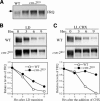
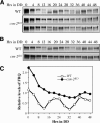
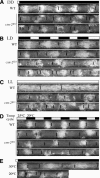
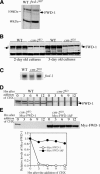
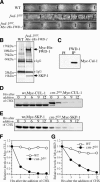
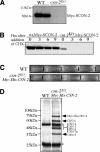
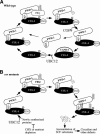
References
-
- Akten B., Jauch, E., Genova, G.K., Kim, E.Y., Edery, I., Raabe, T., and Jackson, F.R. 2003. A role for CK2 in the Drosophila circadian oscillator. Nat. Neurosci. 6: 251–257. - PubMed
-
- Aronson B., Johnson, K., Loros, J.J., and Dunlap, J.C. 1994a. Negative feedback defining a circadian clock: Autoregulation in the clock gene frequency. Science 263: 1578–1584. - PubMed
-
- Busch S., Eckert, S.E., Krappmann, S., and Braus, G.H. 2003. The COP9 signalosome is an essential regulator of development in the filamentous fungus Aspergillus nidulans. Mol. Microbiol. 49: 717–730. - PubMed
Publication types
MeSH terms
Substances
Grants and funding
LinkOut - more resources
Full Text Sources
Other Literature Sources
Research Materials
Miscellaneous
